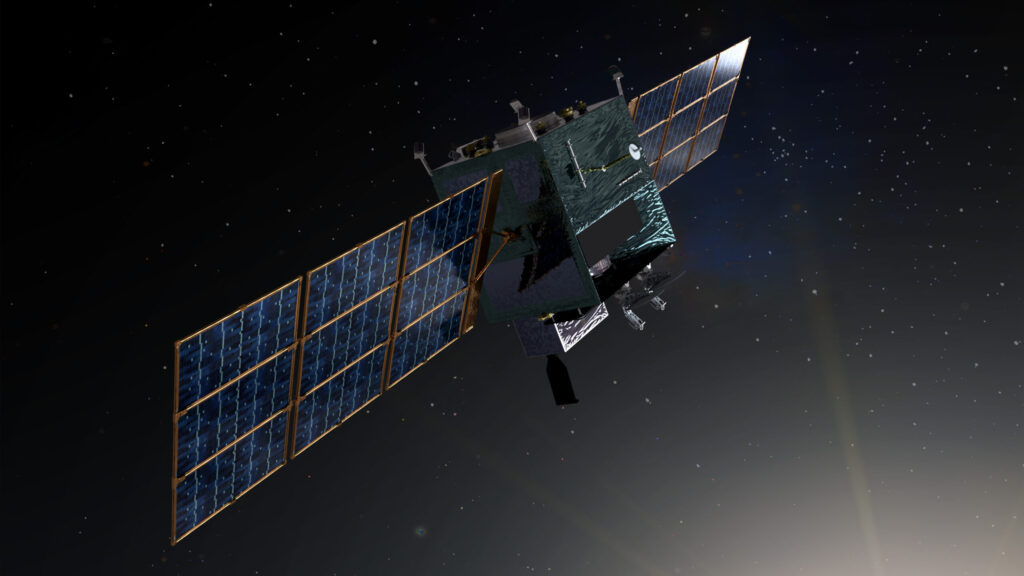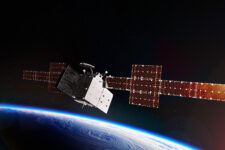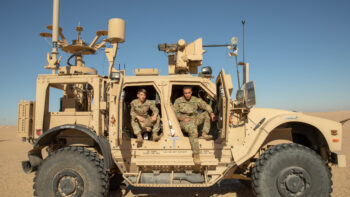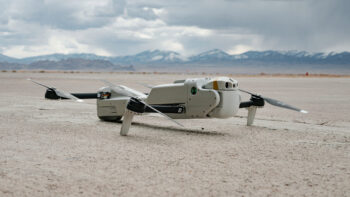
As part of the Next Generation Overhead Persistent Infrared System (Next-Gen OPIR), two polar satellites will provide coverage over the northern hemisphere. (Graphic: Northrop Grumman)
WASHINGTON — The Space Force’s flagship but somewhat troubled missile warning satellite development program is babystepping its way toward deployment of both its space and ground segments — although the first of the Next Generation Overhead Persistent Infrared (Next-Gen OPIR) birds may well miss its planned 2025 launch into geosynchronous Earth orbit (GEO) by a year.
Over the past two weeks, the Space Force announced incremental progress on two of the three-pronged program’s subprojects, but it also saw a key official’s warning to lawmakers the timeline may have shifted for the third leg.
Next-Gen OPIR is being developed as the replacement for the current missile warning constellation, the Space-Based Infrared System (SBIRS). All six dedicated SBIRS satellites in GEO are operational as of last March. There also are two SBIRS sensors operating as hosted payloads on classified satellites in highly elliptical over the poles.
Next-Gen OPIR will include only four satellites, two in GEO and two in polar orbit — as the Space Force moves to a dispersed set of more modern satellites in lower orbits capable of not just warning about missile launch but also tracking them through the heavens.
In addition, a new, highly automated ground system, called Future Operationally Resilient Ground Evolution (FORGE), is being developed to provide day-to-day operations and command and control (C2) for Next-Gen OPIR, and eventually of all the service’s missile warning constellations. FORGE, led by RTX (formerly Raytheon), long has been suffering from developmental problems, with the Government Accountability Office last June warning key pieces of the multi-faceted ground system would not be ready in time to provide C2 for the first of the Next-Gen OPIR satellites.
Steps Forward: Polar Sats, FORGE Advance
The Space Force’s primary acquisition unit, Space Systems Command (SSC), on April 29 announced that the Next-Gen polar effort has passed its critical design review. This “major milestone” for the program “confirms the detailed design maturity and readiness to proceed with system fabrication, coding, assembly, integration, and test of the space vehicle,” the release explained.
Lt. Col. Nicholas Laliberte, materiel leader for SSC’s NGP program, said that the “successful CDR milestone shows the space vehicle meets standards and is on track to continue our launch planning efforts.”
The polar satellites are being developed by prime contractor Northrop Grumman, which is aiming for a 2028 launch.
SSC also recently announced [PDF] a small victory in getting the FORGE system into operations, with a first software package delivery to the Overhead Persistent Infrared (OPIR) Battlespace Awareness Center (OBAC) at Buckley SFB in Colorado.
“OBAC performs the Battlespace Awareness/Technical Intelligence mission in support of the Theatre missile warning for the United States Space Force,” said Lt. Col. Morgan Sparks, SSC’s materiel leader for the FORGE program, in an April 29 email. The new software, she explained, will increase cybersecurity and help OBAC operators in their battlespace awareness mission.
The new software “is focused on detecting [and] processing missile tracks around the globe in support of the Nation’s missile warning mission,” she said, and “is focused on data processing.”
The delivery included “a software package (mission processing application + services needed to run the application) as well as the software platform and supporting hardware,” Sparks said.
Specifically, it provides the base for the FORGE Mission Data Processing Application Framework (MDPAF), which is the open-source, software-centric backbone for collecting and processing data from the various missile warning satellites.
Sparks added that the new software “provides significant cybersecurity improvements over the current system. In addition, it is the delivery of a [government-]owned, open, modular architecture to ensure that we can rapidly respond to adversarial threats with the best capabilities provided by a variety of industry partners.”
It will be followed by “a second operational delivery following later this year with an additional mission data processing application suite,” she said. “Additional capabilities will be incrementally delivered to keep pace with the threat, including extending FORGE to the strategic ITW/AA [Integrated Tactical Warning and Attack Assessment] mission in 2026.”
However, what this first FORGE product delivery does not do is move the ball on the lagging FORGE C2 software, which will be required to operate the Next-Gen OPIR satellites. The current plan is for an “interim” C2 system built by Lockheed Martin to provide baseline capabilities for launch, early on-orbit testing and command and control capabilities for launch, early on-orbit testing, and initial operations.
And Back: Next-GEN GEO Launch May Slip To 2026
Meanwhile, first Next-Gen GEO bird is running about a year behind schedule, due to issues with its sensor payload being also built by RTX — although both the Space Force and prime contractor Lockheed Martin up to now have been hoping to be able rejigger activities in order to meet the 2025 launch date.
However, in testimony before the House Armed Services Committee (HASC) on April 30, Frank Calvelli, the Air Force’s head of space acquisition, appeared to be laying the groundwork for that date to slip. While saying that the Next-Gen GEO “is continuing to make progress,” he raised the prospect that the first satellite might not be launched until 2026.
“We have some challenges making sure that the mission payload gets delivered. It’s about a year late and we’re tracking that really closely. It should arrive this summer for integration into the satellite and for a launch in … early ’25 or early -26,” he said.






















